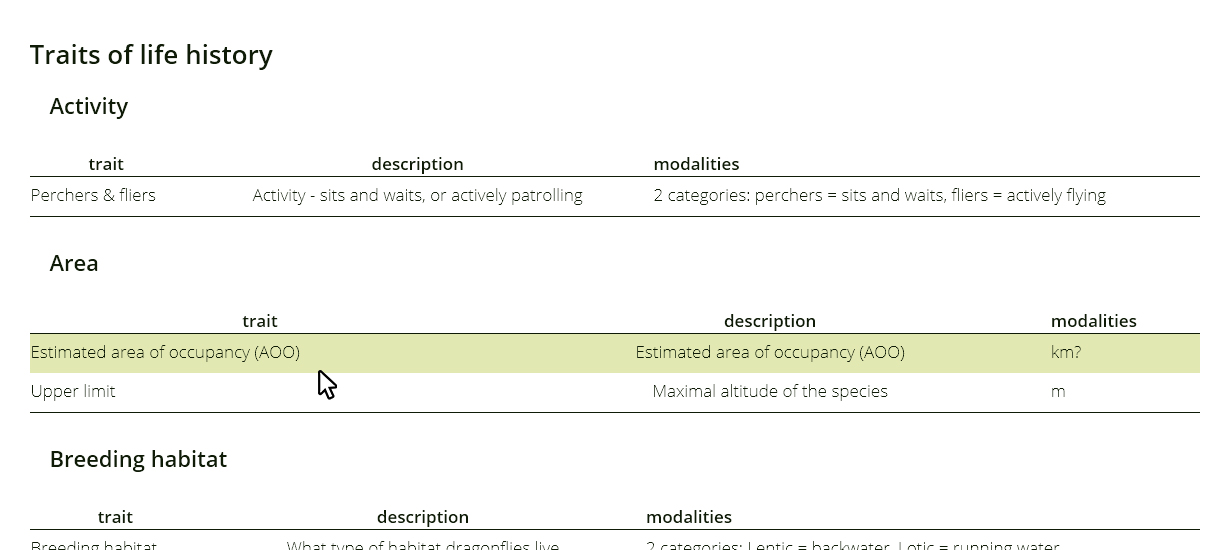
Climate change and an ever-increasing degree of influence on most ecosystems increases the need to understand not only the effects of these influences but also the functional links between organisms. The subject of the study of many ecological disciplines is no longer diversity, but "functional diversity" (Levine, 2015).
The features used to describe organisms from a functional point of view are called "traits" (Shipley, 2010). As a "trait" we refer to a "selective value of organisms" that allow us to understand interactions between organisms and their environment (Shipley, 2010). Lack of information about the features of organisms and also a limited analytical tools were the main reason why functional ecology did not apply much earlier (Levine, 2015). With the development of comprehensive trait databases in the last few decades, however the whole functional ecology begins to flourish (Violle et al., 2007) but see (Cadotte and Tucker, 2017).
The fact that different authors under the same term represent a different feature has led several authors to compile a clear manual for a uniform measurement of functional traits for different groups of organisms (Moretti et al., 2017).

Now, when there are definite rules, we have a basis for creating a database. Surprisingly, information on dragonflies and damselflies are very basic and/or are completely missing in hydrobiological databases e.g. (Schmidt-Kloiber and Hering, 2015). As far as we know, so far there is only one database of summarizing traits of European dragonflies and damselflies – Morphological and geographical traits of the British Odonata (Powney et al., 2014). Practical use of this database is however limited. This database is based on a few sources and it is focused only on species occurring in the UK and contains only traits for imagoes. That's why we decided to create a completely new database - dragons-database.eu.



Currently, we have compiled information about the traits of central European species and in the future we would like to include all species occurring in Europe. This database is based on the available published sources in books and scientific articles (WOS, Scopus). Our goal is to create an open database that will expand with newly published sources and data from unpublished studies.
We try to maintain an informative value of individual traits by providing basic information about the study (number of individuals, the temperature, ex situ / in situ) for all life stages. At the same time, we wanted to at least partially preserve the variability in data. Average values often do not clearly provide meaningful information about a specific trait. To our surprise, we were unable to find seemingly basic data on the numbers of individuals on which a given trait is measured. It seems that, especially in book sources, authors often take uncritically information from other sources or for some reason do not mention this information.

During the compilation of the database, we encountered a critical lack of information about traits of some species. That's why we would like to ask you for information about individual species. Even one piece of information can have a great value to us!
3. Corbet, P.S. & Brooks, S.J., 2008: Dragonflies. Collins, London, UK, 312 p.
7. Daguet, C.A., French, G.C. & Taylor, P., 2008: The Odonata Red Data List for Great Britain. Species Status 11; 1-34. Joint Nature Conservation Committee, Peterborough, UK, 36 p.
15. Rüppell, G. et al., 2005: Die Prachtlibellen Europas. Die Neue Brehm-Bücherei Band 654, Westarp Wissenschaften Hohenwarsleben, Germany, 255 p.
20. Hilfert-Rüppell, D., 1999: To stay or not to stay: decision-making during territorial behaviour of Calopteryx haemorrhoidalis and Calopteryx splendens splendens(Zygoptera: Calopterygidae).International Journal of Odonatology, 2: 167-175.
31. Peters, G., 1987: Die Edellibellen Europas: Aeshnidae. Ziemsen Verlag, Wittenberg, Germany, 140 p.